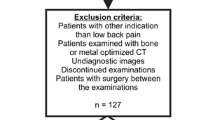Abstract
Aim: To compare the diagnostic accuracy of low-dose computed tomography (CT), magnetic resonance imaging (MRI) and fluoroscopy in percutaneous discography in patients scheduled for lumbar spondylodesis. Material and methods: Within a prospective pilot study, 18 disc segments of 11 patients with radicular or pseudoradicular pain prior to anteroposterior spondylodesis were evaluated. After injection of a mixture of non-ionic iodine-containing contrast agent and gadolinium-based contrast medium into the disc spaces, all patients underwent conventional fluoroscopy, as well as low-dose CT and MRI. The occurrence of memory pain during contrast injection was recorded. CT, MRI and fluoroscopic images were analyzed independently by two readers blinded to the clinical findings. Results: There was 100% agreement between CT and MRI discography in the detection, localization and grading of degenerative changes. In contrast, conventional fluoroscopy identified only 9 of the 12 abnormal segments. Memory pain following puncture was identified in 3 of the 12 affected segments. Summary: Low-dose CT and MRI discography have a similar accuracy in the assessment of disc disruption and they are superior to fluoroscopic discography.



Similar content being viewed by others
References
Anderson SR, Flanagan B (2000) Discography. Curr Rev Pain 4:345–352
Bernard TN (1994) Using computed tomography/discography and enhanced magnetic resonance imaging to distinguish between scar tissue and recurrent lumbar disc herniation. Spine 19:2826–2832
Bogduk N, Modic MT (1996) Lumbar discography. Spine 21:402–404
Calzado A, Rodriguez R, Munoz A (2000) Quality criteria implementation for brain and lumbar spine CT examinations. Br J Radiol 73:384–395
Carragee EJ, Chen Y, Tanner CM, Truong T, Lau E, Brito JL (2000) Can discography cause long-term back symptoms in previously asymptomatic subjects? Spine 25:1803–1808
Carragee EJ, Barcohana B, Alamin T, van den Haak E (2004) Prospective controlled study of the development of lower back pain in previously asymptomatic subjects undergoing experimental discography. Spine 29:1112–1117
Cohnen M, Poll LW, Puettmann C, Ewen K, Saleh A, Mödder U (2003) Effective doses in standard protocols for multi-slice CT scanning. Eur Radiol 13:1148–1153
Collins CD, Stack JP, O’Connell DJ, Walsh M, McManus FP, Redmond OM, Ennis JT (1990) The role of discography in lumbar disc disease: a comparative study of magnetic resonance imaging and discography. Clin Radiol 42:252–257
Connor PM, Darden BV (1993) Clinical discography complications and clinical efficacy. Spine 18:2035–2038
Eisenstein S, Roberts S (2003) The physiology of the disc and its clinical relevance. J Bone Joint Surg Br 85:633–636
Falco FJ, Moran JG (2003) Lumbar discography using gadolinium in patients with iodine contrast allergy followed by postdiscography computed tomography scan. Spine 28:E1–E4
Grasshoff H, Kayser R, Mahlfeld U, Mahlfeld K (2001) Discography findings and results of percutaneous laser disk decompression. Rofo 173:191–194
Guyer RD, Ohnmeiss DD (2003) Lumbar discography. Spine J 3:11S–27S
Hirsch C, Inglemark BE, Miller M (1963) The anatomical basis for low back pain. Acta Orthop Scand 33:1–17
Huang TS, Zucherman JF, Hsu KY, Shapiro M, Lentz D, Gartland J (2002) Gadopentetate dimeglumine as an intradiscal contrast agent. Spine 27:839–843
Lindblom K (1948) Diagnostic puncture of intervertebral disks in sciatica. Acta Orthop Scand 17:231–238
Min K, Leu HJ, Perrenoud A (1996) Discography with manometry and discography CT: their value to patient selection for percutaneous lumbar nucletomy. Bull Hosp Jt Dis 54:153–157
Mini R (1995) Strahlenexporition in der Rőntgendiagnostik ssk Verőeffentlichungen. Band 30:49–74
Modic M, Masaryk T, Ross J, Carter J (1988) Imaging of degenerative disk disease. Radiology 168:177–186
Ohnmeiss DD, Vanharanta H, Ekholm J (1999) Relation between pain location and disc pathology: a study of pain drawings and CT/discography. Clin J Pain 15:210–217
Parfenchuck TA, Janssen ME (1994) A correlation of cervical magnetic resonance imaging and discography/computed tomographic discograms. Spine 19:2819–2825
Pearce RH, Thompson JP, Bebault GM, Flak B (1991) Magnetic resonance imaging reflects the chemical changes of aging degeneration in the human intervertebral disk. J Rheumatol Suppl 27:42–43
Poynton AR, Hinman A, Lutz G, Farmer J (2005) Discography-induced acute lumbar disc herniation: a report of five cases. J Spinal Disord Tech 18(2):188–192
Osti OL, Fraser RD, Vernon-Roberts B (1990) Discitis after discography. The role of prophylactic antibiotics. J Bone Joint Surg Br 72:271–274
Sequeiros RB, Klemola R, Ojala R, Jyrkinen L, Vaara T, Tervonen O (2003) Percutaneous MR-guided discography in a low-field system using optical instrument tracking: a feasibility study. J Magn Reson Imaging 17:214–219
Stamm G, Nagel HD (2002) CT-expo—a novel program for dose evaluation in CT. Rofo 174:1570–1576
Weishaupt D, Zanetti M, Hodler J, Min K, Fuchs B, Pfirrmann CW, Boos N (2001) Painful lumbar disk derangement: relevance of endplate abnormalities at MR imaging. Radiology 218:420–427
Willems PC, Jacobs W, Duinkerke E, De Kleuver M (2003) Lumbar discography: should we use prophylactic antibiotics? a study of 435 consecutive discograms and a systematic review of the literature. J Spinal Disord Tech 17:243–247
Author information
Authors and Affiliations
Corresponding author
Rights and permissions
About this article
Cite this article
Kluner, C., Kivelitz, D., Rogalla, P. et al. Percutaneous discography: comparison of low-dose CT, fluoroscopy and MRI in the diagnosis of lumbar disc disruption. Eur Spine J 15, 620–626 (2006). https://doi.org/10.1007/s00586-005-1030-3
Received:
Revised:
Accepted:
Published:
Issue Date:
DOI: https://doi.org/10.1007/s00586-005-1030-3




